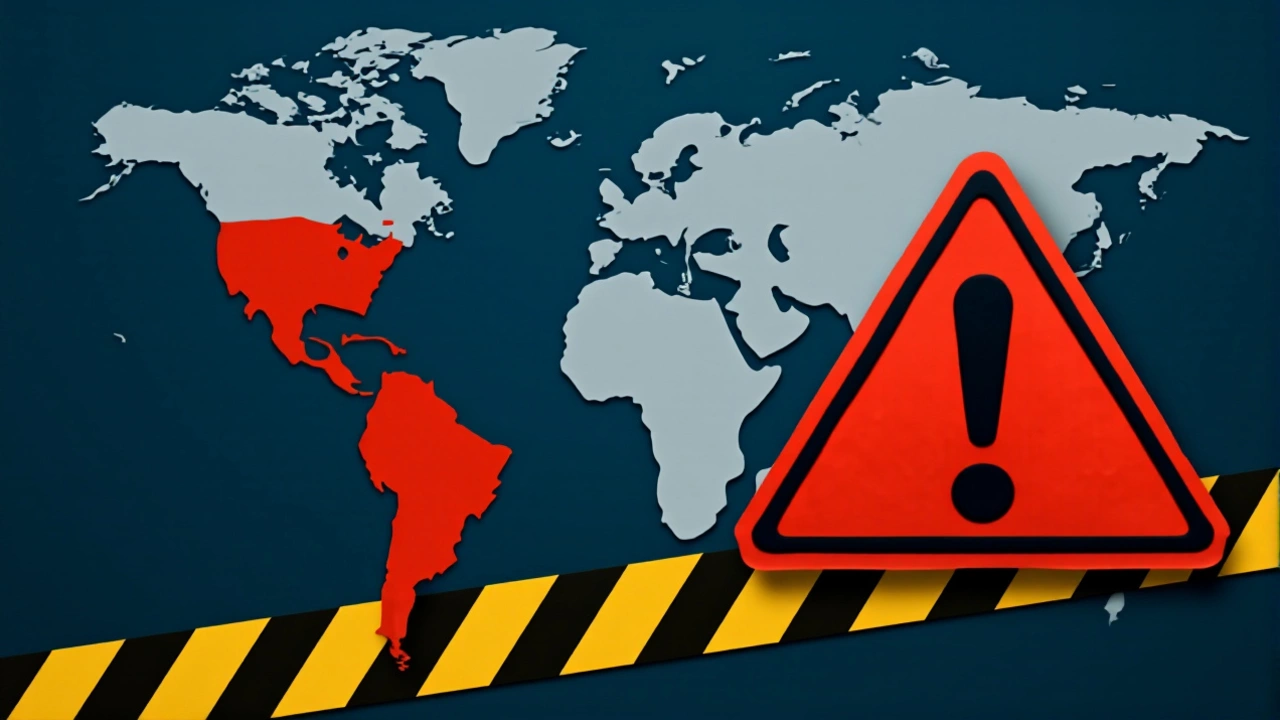As of August 12, 2025, the U.S. Department of State maintains a Level 2 ‘Exercise Increased Caution’ advisory for Mexico — a stance unchanged for over a year — even as cartel violence escalates and U.S. citizens face direct threats. The warning, posted on Travel.State.gov, cites terrorism, crime, and kidnapping as ongoing dangers, with several regions crossing into the highest-risk Level 4 category. Meanwhile, Paraguay has drawn a far more urgent response from Canada’s government, which now advises travelers to avoid non-essential trips due to organized crime, even as the U.S. State Department still rates it Level 1 — a stark contrast that’s leaving travelers confused and agencies scrambling to reconcile their guidance.
Where Mexico Is Most Dangerous — And Why
The danger isn’t spread evenly across Mexico. Tamaulipas, the state bordering Texas, is ground zero. Cities like Matamoros, Nuevo Laredo, and Rio Bravo sit at Level 4 — ‘Do Not Travel.’ Why? Because of the bombs. On January 23, 2025, a criminally manufactured IED destroyed a U.S. government vehicle in Rio Bravo, injuring one person. Since then, U.S. Consulate General in Nuevo Laredo and Matamoros has barred employees from traveling on dirt roads after dark. Tourists are now being warned: don’t touch strange objects on rural roads. In Reynosa, Valle Hermoso, and San Fernando, Mexican authorities have posted signs: “Do not move or touch.” These aren’t abandoned packages. They’re weapons.Gunfire isn’t rare. In fact, the State Department says it’s becoming increasingly frequent — especially in the corridor between Hermosillo and Nogales. Even Chihuahua City, a popular destination for retirees, carries a Level 3 warning. And then there’s the Pacific Coast. Manzanillo, once a cruise stop for Royal Caribbean, was downgraded to Level 4 in 2024. The cruise line pulled out immediately. No more ships. No more tourists. Just silence where there used to be music and margaritas.
Cartel Threats Are No Longer Vague
This isn’t just about random violence. On May 10, 2025, a chilling message surfaced in Spanish, posted on social media and circulated in cartel networks: “You will be the ones to blame. We’ll show how we’ll make this war starting 5/10/2025 on all Americans residing in areas where we have a presence… especially those living in San Jose del Cabo and Cabo San Lucas.” The threat was signed by an unknown faction, but the intent was unmistakable. The U.S. Embassy & Consulates in Mexico didn’t ignore it. They issued a winter travel alert on September 6, 2025, reiterating the Level 2 warning — and specifically mentioning the threat. This wasn’t a generic bulletin. It was a direct response to a named target: Americans vacationing in the Los Cabos region.What makes this different from past warnings? The specificity. Previous threats were broad: “Americans are targets.” Now, they’re naming places, dates, and even tactics. The cartels aren’t just fighting each other anymore. They’re signaling they’re willing to escalate against U.S. civilians. And they’re doing it in plain sight.
Paraguay: A Warning That Doesn’t Match
While Mexico is under fire for its internal chaos, Paraguay is facing a different kind of storm — one that’s political, not just criminal. Canada’s government issued a “Regional Advisory – Avoid Non-Essential Travel” for Paraguay, citing “high levels of violence and organized crime.” The message is clear: stay away unless you absolutely must go. But here’s the odd part: the U.S. State Department still rates Paraguay as Level 1 — “Exercise Normal Precautions.”The discrepancy isn’t just bureaucratic. It’s dangerous. Canadian travelers are being told to avoid entire regions. American travelers? They’re told to lock their doors and watch their wallets. Why the gap? One possible reason: Canada has a more aggressive intelligence-gathering presence in Latin America, particularly in regions with strong organized crime ties. Another: Canada’s travel advisory system is more responsive to ground-level reports from its embassies. The U.S. system, by contrast, relies on longer review cycles — and its last update for Paraguay was April 30, 2025, which may not reflect recent unrest.
According to Travel and Tour World, Paraguay saw Gen Z-led protests in 2025 alongside Peru, Ecuador, and Chile. These weren’t massive marches — more like sporadic street blockades and online mobilizations. But they’re enough to create instability. And in a country where police resources are stretched thin, even small protests can spiral. The advice from Canadian officials? Stick to tourist zones. Avoid rallies. Don’t assume safety just because you’re in Asunción.

What This Means for Travelers
Millions of Americans visit Mexico each year — 27 million in 2024 alone, according to U.S. Customs and Border Protection. Most go to Cancún, Puerto Vallarta, or the Riviera Maya — places still rated Level 2. But the problem isn’t just the destination. It’s the route. The drive from Texas to Monterrey? High risk. The backroads from Hermosillo to Nogales? Even riskier. The State Department’s maps, last updated May 2, 2024, are already outdated. New IED placements, shifting cartel turf, and unreported shootings aren’t reflected.For those planning winter trips — the so-called “snowbirds” heading south for the season — the message is simple: don’t assume safety. Check the State Department’s site the day before you leave. Avoid dirt roads. Don’t carry large sums of cash. And if you’re heading to Tamaulipas? Don’t go at all. Even if you’ve been there before. The rules have changed.
And for Paraguay? If you’re Canadian, heed the warning. If you’re American, don’t be lulled by the Level 1 rating. The U.S. government may not see the threat yet — but that doesn’t mean it isn’t there. The same cartels that operate in Mexico have networks in Paraguay. The same weapons move through the same corridors. The same people are watching.
What’s Next?
The U.S. State Department is expected to review its Mexico advisory again by November 2025. But given the escalating threats — and the fact that a cartel has now openly declared war on U.S. citizens — many experts believe a broader Level 3 upgrade for multiple states is likely. Meanwhile, Canadian officials are reportedly pushing the U.S. to align its Paraguay advisory. “We’re not trying to scare people,” said a senior Canadian Foreign Affairs official anonymously. “We’re trying to save lives.”For now, the message is clear: travel advisories are no longer just recommendations. They’re survival guides.
Frequently Asked Questions
Why does the U.S. still rate Mexico at Level 2 when some areas are Level 4?
The U.S. State Department uses a tiered system where the national advisory reflects the overall risk, while specific regions carry higher ratings. Level 2 means most of Mexico is still accessible with caution, but Level 4 zones like Tamaulipas are off-limits. This allows travelers to make informed choices without blanket bans — though critics argue it creates confusion and false security.
What should I do if I’m already in Tamaulipas?
Leave immediately if possible. Avoid all non-essential travel, especially after dark. Do not use dirt roads or secondary highways. Contact the nearest U.S. consulate — in Monterrey or Ciudad Juarez — and register with the Smart Traveler Enrollment Program (STEP). Keep your phone charged and your documents secure. If you hear gunshots or see unattended packages, get indoors and call local authorities.
Are cruise lines still stopping in Mexico?
Yes — but only in safer ports. Royal Caribbean no longer stops in Manzanillo after its Level 4 advisory. Major lines like Carnival and Norwegian still dock in Cabo San Lucas, Puerto Vallarta, and Ensenada — all Level 2. But they monitor U.S. advisories closely. If Mexico’s rating rises, expect more cancellations. Always check your cruise line’s website for real-time updates before departure.
Why does Canada warn about Paraguay but the U.S. doesn’t?
Canada’s advisory is based on real-time intelligence from its embassy in Asunción and reports of increasing violence linked to organized crime and protests. The U.S. system prioritizes consistency and slower, data-driven reviews. While the U.S. sees crime as a general concern, Canada interprets the same data as a systemic threat. The difference reflects varying risk tolerance — not necessarily a difference in facts.
How reliable are these travel advisories?
They’re among the most reliable public sources available, but they’re not perfect. Updates lag behind events — like the January 2025 IED blast in Rio Bravo, which wasn’t reflected in the August 2025 advisory. Always cross-check with local news, embassy alerts, and traveler forums. If multiple sources report the same danger, take it seriously — even if the official advisory hasn’t changed yet.
What’s the biggest mistake travelers make when reading these advisories?
Assuming Level 2 means “safe.” It doesn’t. It means “be alert.” Many tourists think Level 2 is like a yellow light — slow down, but keep going. In reality, it’s a red flag for crime spikes, cartel activity, and unpredictable violence. The safest travelers are the ones who plan ahead, avoid risky areas, and never assume they’re immune because they’re “just tourists.”

 Sports
Sports